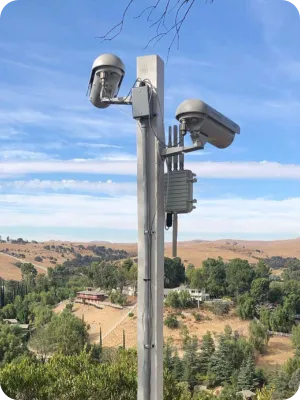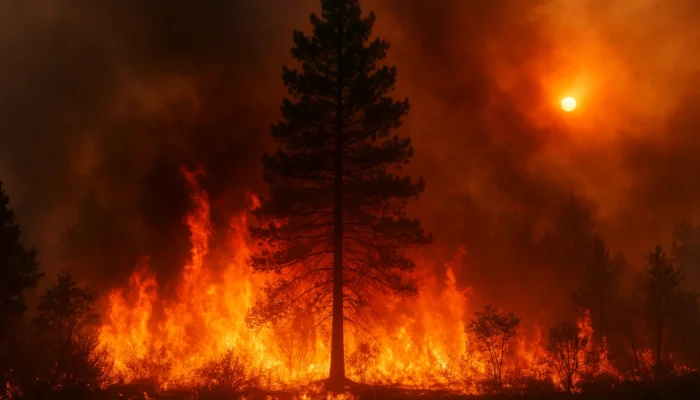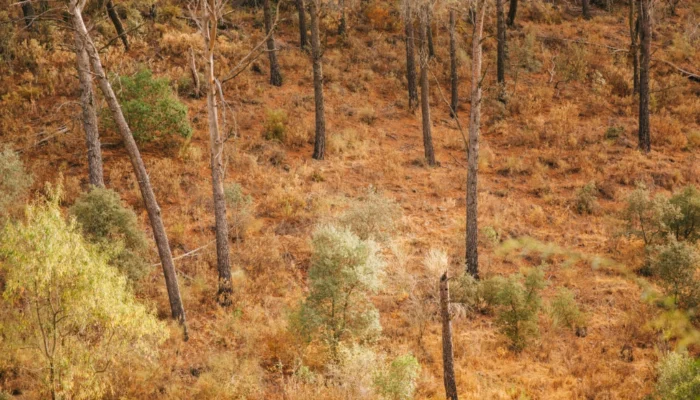Heatwaves have become a powerful symbol of the changing climate, and when long stretches of extreme heat settle over a region they create conditions that can transform ordinary landscapes into dangerous environments where the threat of destructive fires becomes far more intense, which is why understanding the connection between long hot periods and the rise in firestorms is becoming an urgent issue for scientists, communities, and policymakers who want to protect both natural ecosystems and human lives in a world that is warming faster than many earlier predictions had suggested.
In recent years, cities and rural regions alike have seen record temperatures stacking up year after year, and this escalation is not only uncomfortable for people trying to go about their daily lives but also represents a dramatic shift in environmental conditions that ripple outward in ways that affect forests, grasslands, water supplies, animal behavior, and even the health of the soil itself. As temperatures climb and remain high for longer stretches of time, plants lose moisture more quickly, small fires ignite more easily, and a single spark can set off a chain reaction that overwhelms fire crews, spreads across vast distances, and turns into a firestorm, which is a destructive type of wildfire capable of generating its own wind and heat in a terrifying feedback loop that grows stronger the longer it burns.
The relationship between extreme heat and firestorms is not simply a coincidence; it is a pattern that scientists have been tracking for years, and they increasingly warn that without mitigation strategies, improved land management, and broader action on climate change, the cycles of severe heat followed by catastrophic fire events will only become more common.
Table of Contents
ToggleWhat Firestorms Are and Why They Matter
A firestorm is not just a large fire; it is an intense, rapidly expanding blaze that grows hot enough to pull in air from all directions, forming powerful inward winds that fuel the flames even more, sometimes reaching temperatures capable of melting metal, destroying entire neighborhoods, and altering the atmosphere around them. Unlike typical forest fires, which can be influenced by weather, terrain, or firefighting efforts, firestorms become so strong and self-sustaining that they can overpower the strategies used to control ordinary fires, creating a scenario where evacuation becomes the only realistic option because the fire behaves like a living force with its own internal system of heat, air, and movement.
Communities in fire-prone regions understand that firestorms can appear suddenly during prolonged periods of dryness, and when one forms, it can leap across roads, ignite structures from a distance due to radiant heat, and spread in unexpected directions due to the intense wind patterns that swirl around the burning core. Entire ecosystems can be transformed in a matter of hours, and what once was a thriving forest or grassland can turn into a barren, ash-covered expanse that takes years or even decades to recover.
.
How Extreme Heat Leads to Rising Fire Risks
When high temperatures settle over an area for days or weeks at a time, the landscape undergoes subtle but dangerous transformations as moisture in plants, trees, and soil evaporates far more quickly than normal, creating tinderbox conditions where even a small ignition source can unleash a rapidly expanding blaze. During these long, hot spells, the air becomes drier, reducing humidity and making it easier for sparks to catch fire, which means electrical lines, unattended campfires, lightning strikes, or even the heat from vehicles parked in tall grass can set off fires that would not have spread as easily under cooler, wetter conditions.
As ground cover dries out, it becomes a perfect fuel source, and once a fire has enough dry material to burn, it generates heat that dries out nearby vegetation even faster, turning a simple fire into a runaway event that moves across hillsides and plains with surprising speed. In many regions where summers are becoming hotter and longer, this chain reaction happens so frequently that firefighters must plan their seasons around the expectation that hot weather will bring not only more fires but more dangerous ones that resist traditional firefighting methods.
.
Scientific Evidence Linking Extreme Heat to Firestorms
Scientists studying climate patterns have been observing the intensifying feedback loop between high temperatures, prolonged dry periods, and the growing number of severe fire events, and much of their research shows that as global temperatures rise, the potential for large-scale firestorms increases as well, particularly in regions already prone to wildfires. Meteorologists and climate researchers analyze soil moisture levels, weather patterns, wind speeds, and vegetation conditions, and across many studies, the conclusion remains the same: long periods of heat make fires more likely, and the hotter and drier the environment becomes, the greater the risk that a wildfire will escalate into a severe firestorm.
Historical fire data reveal that many of the world’s most destructive firestorms occurred during years with unusually warm temperatures. Scientific models predict that these conditions will become more common, not less, as climate change continues to push global weather patterns toward extremes. When temperatures remain high for extended periods, and when rainfall fails to replenish the moisture in the land, ecosystems become fragile and highly flammable, which means that a single spark in the wrong place at the wrong time can unleash destruction on a scale that was once considered rare but is now becoming disturbingly familiar.
During hotter years, satellite observations often show vast regions of forest turning dry and brown much earlier in the season, essentially becoming giant reservoirs of fuel waiting for ignition. Scientists emphasize that this is not a random pattern but a predictable outcome of environmental conditions, and they warn that unless climate change is slowed, future generations may face fire seasons that are longer, more intense, and more damaging than anything seen in the past.
.
Ecological and Human Consequences
Firestorms do more than burn landscapes; they reshape entire ecosystems, alter air quality across continents, disrupt wildlife habitats, and create long-term environmental ripple effects that can persist for decades. When a firestorm rips through a forest, it destroys trees, shrubs, and ground cover that protect soil from erosion, and without these protective layers, rainstorms that arrive in the following months can wash away nutrient-rich soil, leaving behind degraded land that struggles to support new plant growth. This erosion can spread sediment into rivers and lakes, affecting water quality for both wildlife and human communities.
The loss of vegetation also impacts animals that depend on forest ecosystems for food, shelter, and breeding grounds, forcing many species to migrate, adapt, or face population decline. Some animals may benefit from post-fire landscapes in the long term, as certain plants sprout only after fires and provide new sources of food, but during and immediately after a firestorm, the destruction is severe, and many creatures lose their habitats with little time to escape.
Human communities face tremendous challenges as well, because firestorms can destroy thousands of homes in a matter of hours, displace families, damage critical infrastructure, and strain emergency services that are already stretched thin by increasingly unpredictable weather patterns. Air quality deteriorates quickly during and after a firestorm, and smoke from these massive events can travel hundreds or even thousands of miles, affecting people who live far from the fire zone and increasing health risks for individuals with asthma, heart conditions, or other respiratory issues.
The economic impact of firestorms is immense, with costs linked to destroyed property, lost businesses, damaged infrastructure, medical expenses, and reduced tourism in affected regions. Recovery efforts can last years, requiring rebuilding not only structures but also mental health support for people traumatized by the destruction of their homes, communities, and natural surroundings. In many areas, insurers are raising costs or withdrawing coverage due to the growing risks of extreme fires, leaving homeowners with fewer options for financial protection.
.
Mitigation and Adaptation Strategies

Communities across fire-prone regions have begun implementing strategies to reduce the risk of firestorms by combining traditional land management with modern scientific research. One major approach involves controlled burns, which remove excess vegetation before it accumulates into overly dense fuel sources, though these burns require careful planning and ideal weather conditions to ensure that the fire behaves predictably. Forest management teams also clear dead trees, trim thick underbrush, and create firebreaks, which are strategic gaps in vegetation designed to slow or stop the spread of a wildfire.
Homeowners and communities can reduce structural risk by using fire-resistant building materials, clearing dry brush around homes, and maintaining defensible space so that fires have less fuel to consume near structures. Emergency communication networks and early-warning systems help alert residents to approaching fires, giving them more time to evacuate safely. Firefighters use advanced technology such as satellite imagery, drones, and real-time weather data to predict fire behavior and direct resources where they are needed most.
On a broader scale, climate adaptation strategies include developing policies that address the long-term impacts of warming temperatures, improving public infrastructure to withstand extreme weather, investing in sustainable land use, and promoting global efforts to reduce greenhouse gas emissions. Scientists emphasize that reducing the severity of future firestorms will require a combination of local action and global cooperation because the underlying causes of rising temperatures extend far beyond any single community or region.
.
Conclusion
To protect communities and natural landscapes from increasingly severe firestorms, it is essential to recognize how prolonged heat contributes to the environmental conditions that allow intense fires to grow into unstoppable forces, and although the challenges are great, understanding the science behind these events helps guide effective strategies for prevention, response, and long-term resilience, especially as Heatwaves become a more common feature of the changing climate.
The connection between extreme heat and firestorms is backed by scientific research, visible in real-world examples, and increasingly recognized by people living in regions where fire seasons have become longer and more intense. Acknowledging this relationship is a crucial step toward implementing effective strategies that protect both natural ecosystems and human communities from future destruction. In the end, society must confront the reality that rising temperatures are reshaping the world in ways that demand attention, cooperation, and long-term commitment to reducing risks and preserving the environment, which requires acknowledging the role that Heatwaves play in creating dangerous fire conditions and taking serious steps to mitigate their impact before the cycle of heat and fire becomes even more destructive in years to come.




